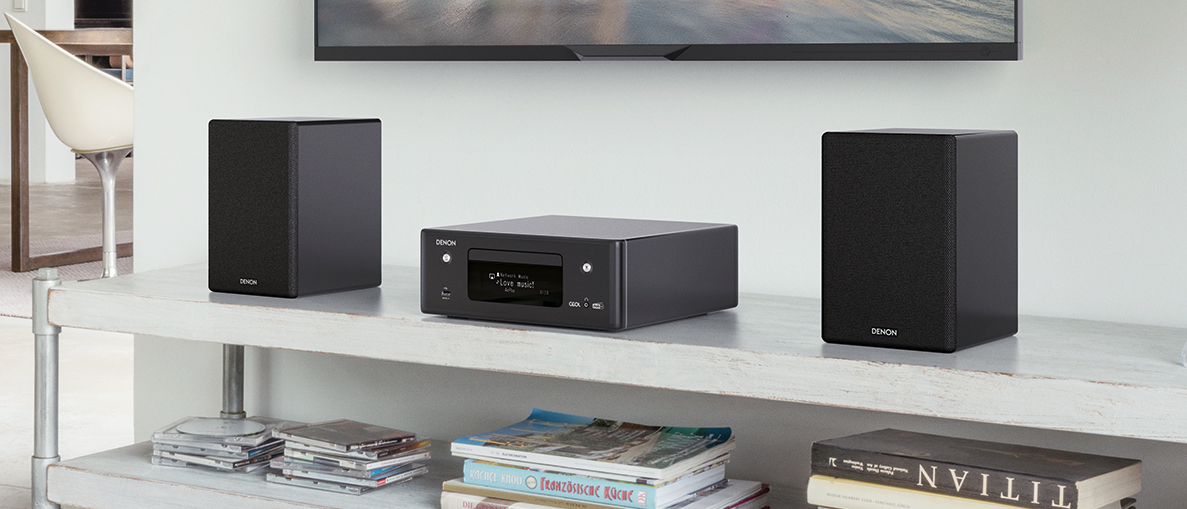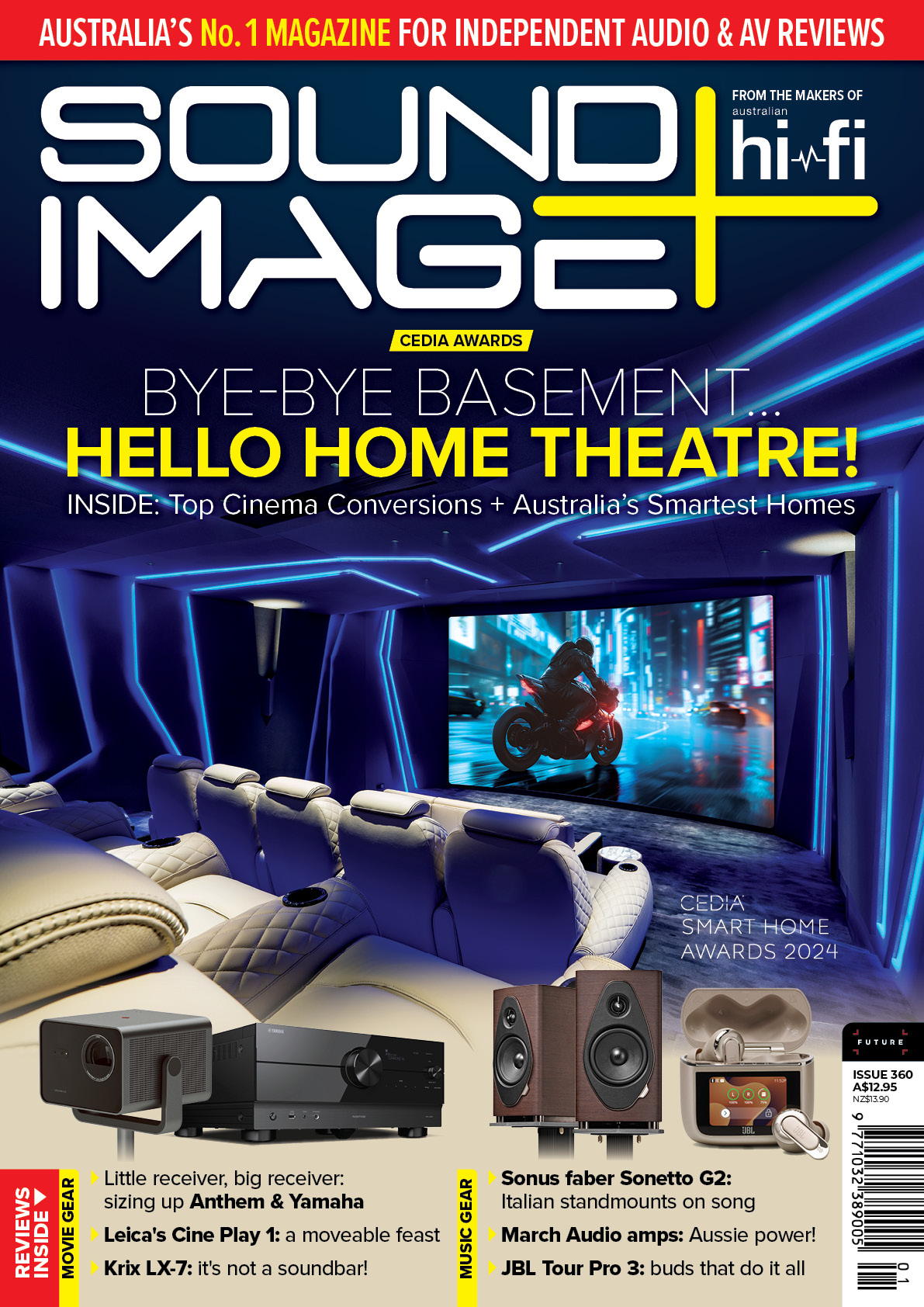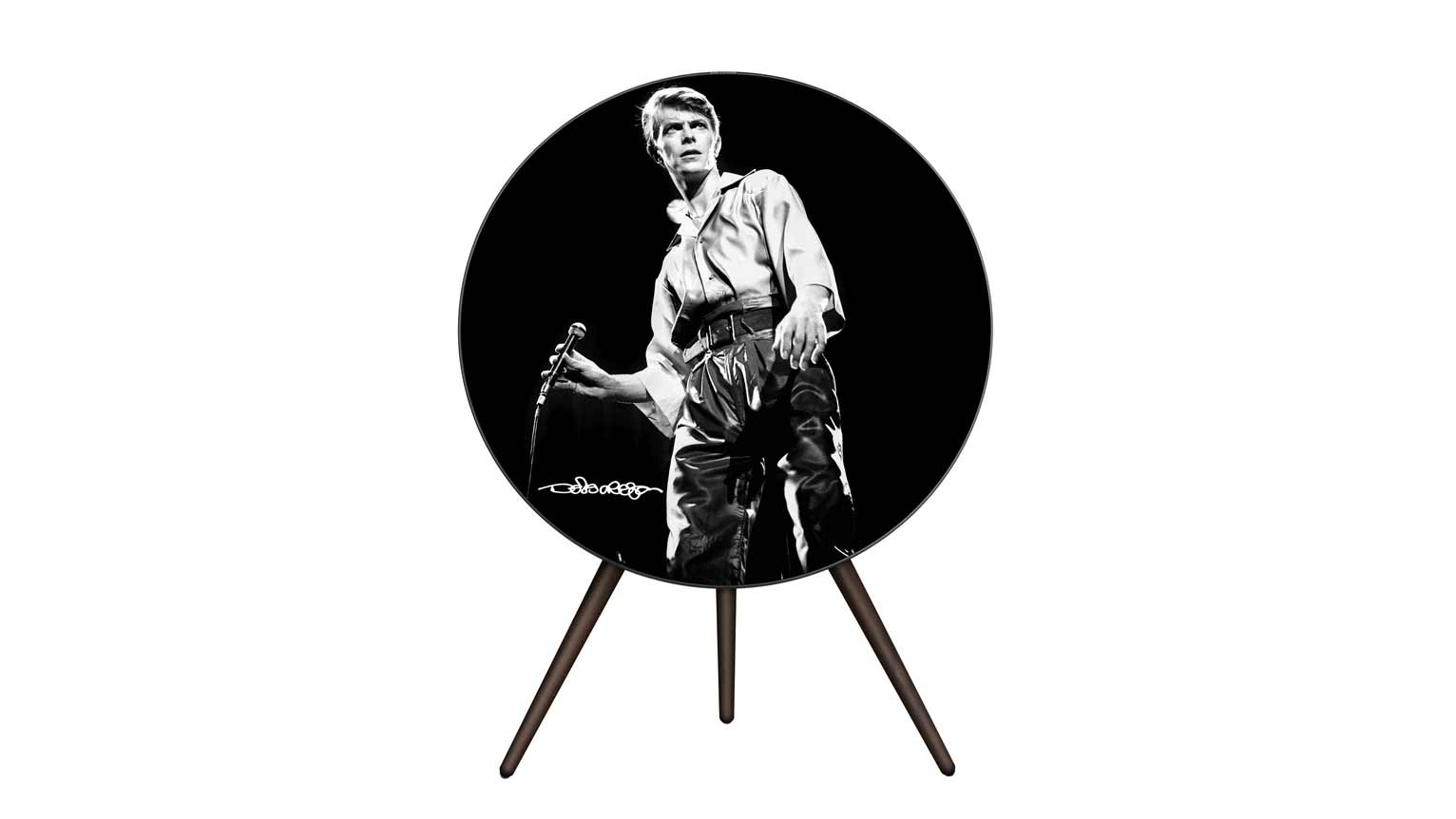Sound+Image Verdict
Music and diversion is exactly what Denon’s all-in-one system delivers, loaded as it is with full streaming abilities in addition to more traditional inputs, plus CD and radio playback.
Pros
- +
Complete all-in-one system
- +
CD player, FM/DAB+ and HEOS
- +
Solid enough hi-fi sound
Cons
- -
No upgradeability in components
Why you can trust What Hi-Fi?
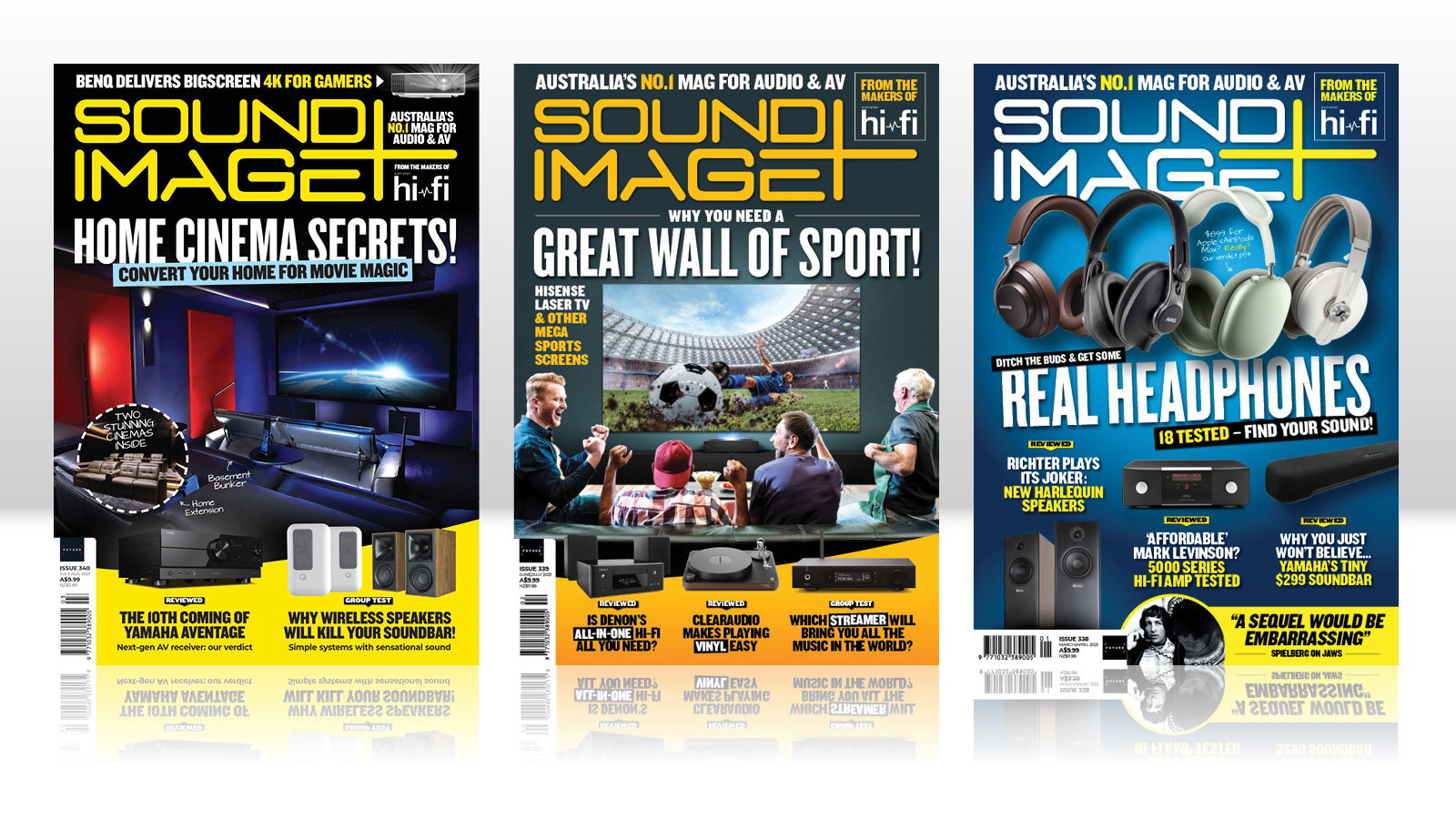
This review originally appeared in Sound+Image magazine, one of What Hi-Fi?’s Australian sister publications. Click here for more information on Sound+Image, including digital editions and details on how you can subscribe.
Back in the elder days of hi-fi, there was an ongoing war of words and, indeed, a philosophical chasm between two breeds of music-making equipment. In one camp stood hi-fi separates – the true path.
In the other: midi systems, the great hulking all-in-one stacks which came topped with a turntable, under which were ranked successive layers of twin cassette, graphic equaliser and amplifier, sometimes with more than their fair share of flashing lights, and partnered with huge but often lightweight speakers of fairly thin MDF.
Later, as CD players replaced turntables, these midi systems shrank down into mini systems and ultimately micro systems (and even, for a while, micro separates), until the whole all-in-one genre was eventually supplanted by the one-box wireless music systems of today.
Denon’s CEOL N11DAB system, then, is a survivor in terms of product genre, but reinvents the breed thanks to updated abilities that are thoroughly modern and all-encompassing for today’s world of streaming and file replay.
What’s more, the inclusion of external inputs and even the quality of its amplification are more separates-level than mini system, while the supplied SC-N10 speakers are no MDF lightweights. And as we shall see, it’s a combination that presents a serious challenge to the box-bound sound of many trendier one-box solutions.
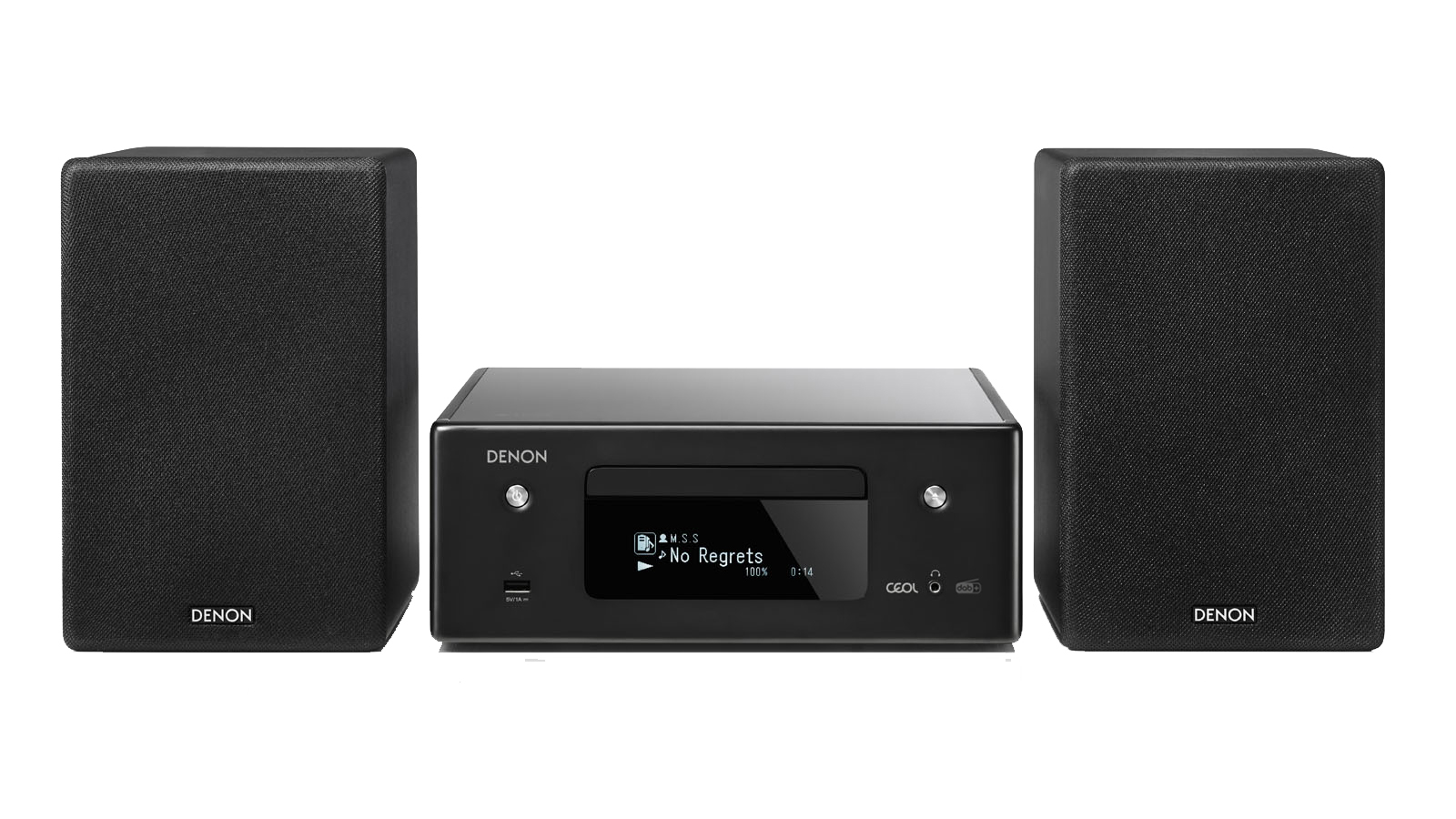
Equipment
We hadn’t previously investigated the etymological origin of Denon’s ongoing CEOL series of systems. The only relevant derivation we could find is the Irish Gaelic word ‘ceol’, originally ceól, meaning ‘music’ or ‘musical instrument’. Should you head out for the night into the cobbled streets of Dublin, you’ll be looking for craic agus ceol – music and diversion (craic is often translated as ‘fun’, but it’s broader than that, with a meaning closer to ‘enjoyable social activity’).
This Gaelic derivation has been confirmed to us (off-the-record, apparently), so this also affects how you should say the word, since its pronunciation is less like ‘seal’ and more like ‘ki-yol’, rhyming with ‘doll’.
And with that, we shall here endeth the language lesson and move to the electronics.
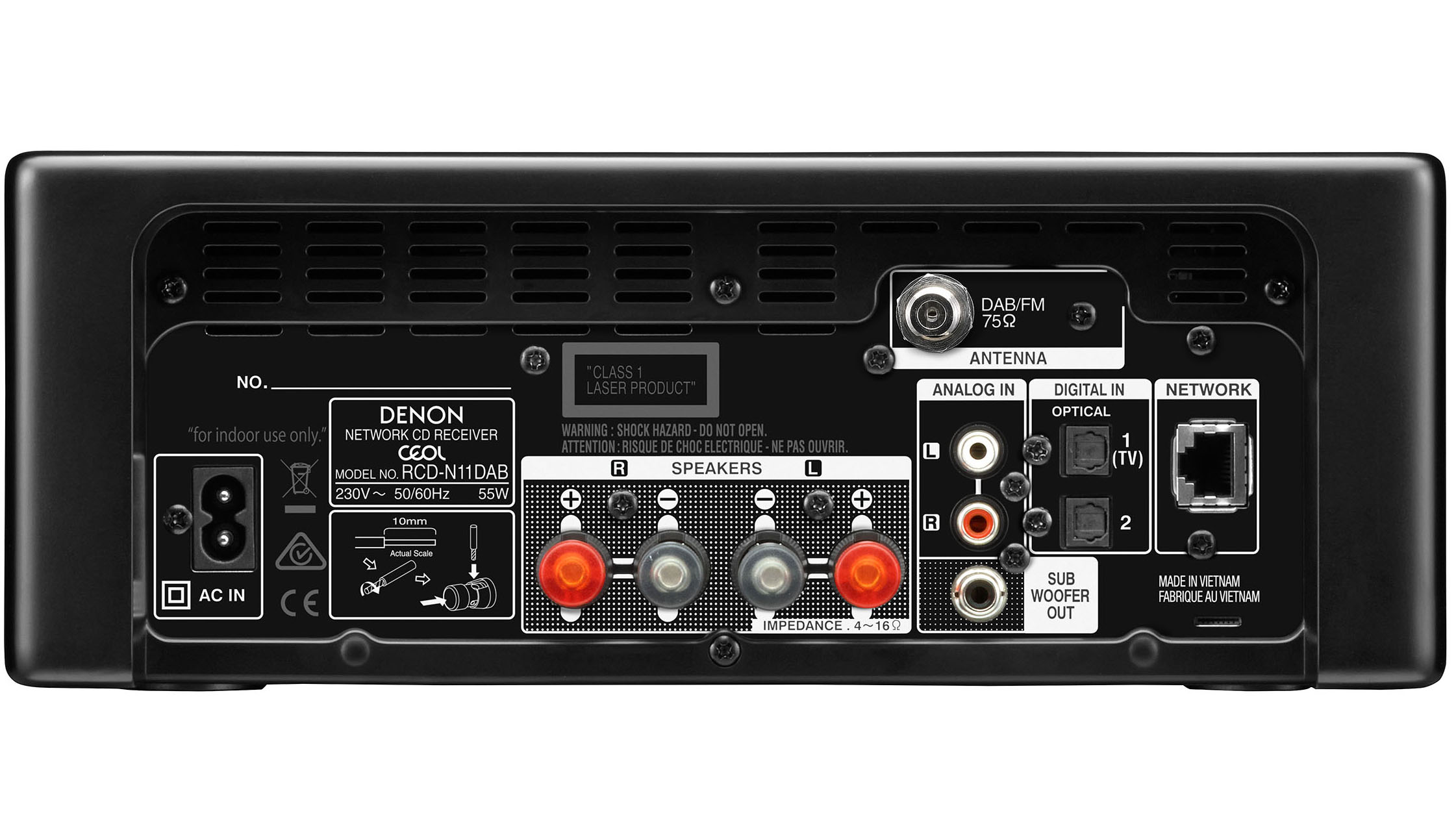
The CEOL N11DAB does so very much that it might be easier to describe what it doesn’t do. So – it doesn’t play vinyl. Or cassettes. Or AM radio.
Everything else is pretty much covered, a great deal of it by the inclusion of the Denon/Marantz wireless multiroom platform HEOS. This you’ll control via the HEOS app on your phone or tablet, and it is one of the best and simplest control apps for such platforms.
Once the unit is networked via either Ethernet cable or Wi-Fi, the Denon unit can use HEOS to access (in the app’s order of listing, see screengrabs below) Spotify, TuneIn, Amazon Music, Deezer, iHeartRadio, SoundCloud, Tidal, music on your device, networked music from shared folders on a computer or NAS drive, and music from an attached USB stick or drive.
We very much appreciate that HEOS is properly localised and doesn’t show services which aren’t available to Australia (as do most rivals, to the ongoing irritation of users).
To use Spotify, the HEOS app simply opens your normal Spotify app, and you select the Denon as the playback device. We were pleased to find that this works for free Spotify as well as subscriptions, which isn’t always the case with other streaming platforms.
As for more traditional sources there are screw-in antennas for the twin radio tuners onboard the Denon, delivering FM and digital DAB+ radio in addition to the internet radio delivered by HEOS. There’s no AM here, but all AM stations are almost certainly available at better quality via internet or DAB+ radio.
There’s also a tray-loading CD player, positioned above the main display, on a front fascia which, despite the multitudinous abilities within, is a veritable study in minimalism, just a power button on the left and a second press button on the right, plus a minijack headphone output (we’d prefer full-size, really) and a USB-A slot front left.
To that last you can attach a stick or USB drive for playback of music files in compressed WMA, AAC or MP3 format, or in uncompressed FLAC, Apple Lossless or WAV format up to 192kHz, and double-DSD (2.8 or 5.6MHz). The drive or stick needs to be formatted as FAT32 or NTFS, and the manual notes that album artwork exceeding 500 × 500 pixels may prevent music being played back properly. This slot won’t play from an iPhone (you can do that via HEOS), but will charge a connected device.
HEOS also delivers multiroom operation. Put another HEOS-compatible player elsewhere in your home and the ‘Rooms’ section of the HEOS app makes it ever so simple to have the same music playing to several or to all HEOS devices at once, whether they be HEOS-equipped soundbars, wireless speakers, even monumental AV receivers. You can also play the inputs of one device over the network to other HEOS devices, but – importantly – only the analogue inputs, not digital ones.
This system has external inputs, though not a vast number – just one analogue RCA pair at line level (no phono input/stage for a turntable), though two useful optical digital inputs, one of which might be used for sound from your TV. (We are great fans of having stereo speakers like those of the N11 combo either side of your TV, or under it, as in the image overleaf, in preference to an often intrusive soundbar in front of it.)
Not only can you select an input from the HEOS app’s ‘Denon CEOL’ pane, there’s a separate ‘inputs’ option. This duplicates the CEOL’s inputs, but if you have other HEOS products around the house, you will also see their inputs here, as additional functionality to the platform’s multiroom operation.
There’s also the ability to have some commands via Google Assistant or Alexa.
The internal amplification is rated as 2 × 65W into four ohms, though this a bit disingenuous given that the supplied speakers are rated at six ohms, so the power delivery will be somewhat less than that. (The other envelopes of qualification on that power figure are that it’s measured at 1kHz only, and with an allowed THD of 0.7%, a rather higher noise level than that at which a hi-fi amplifier would generally be quoted.)
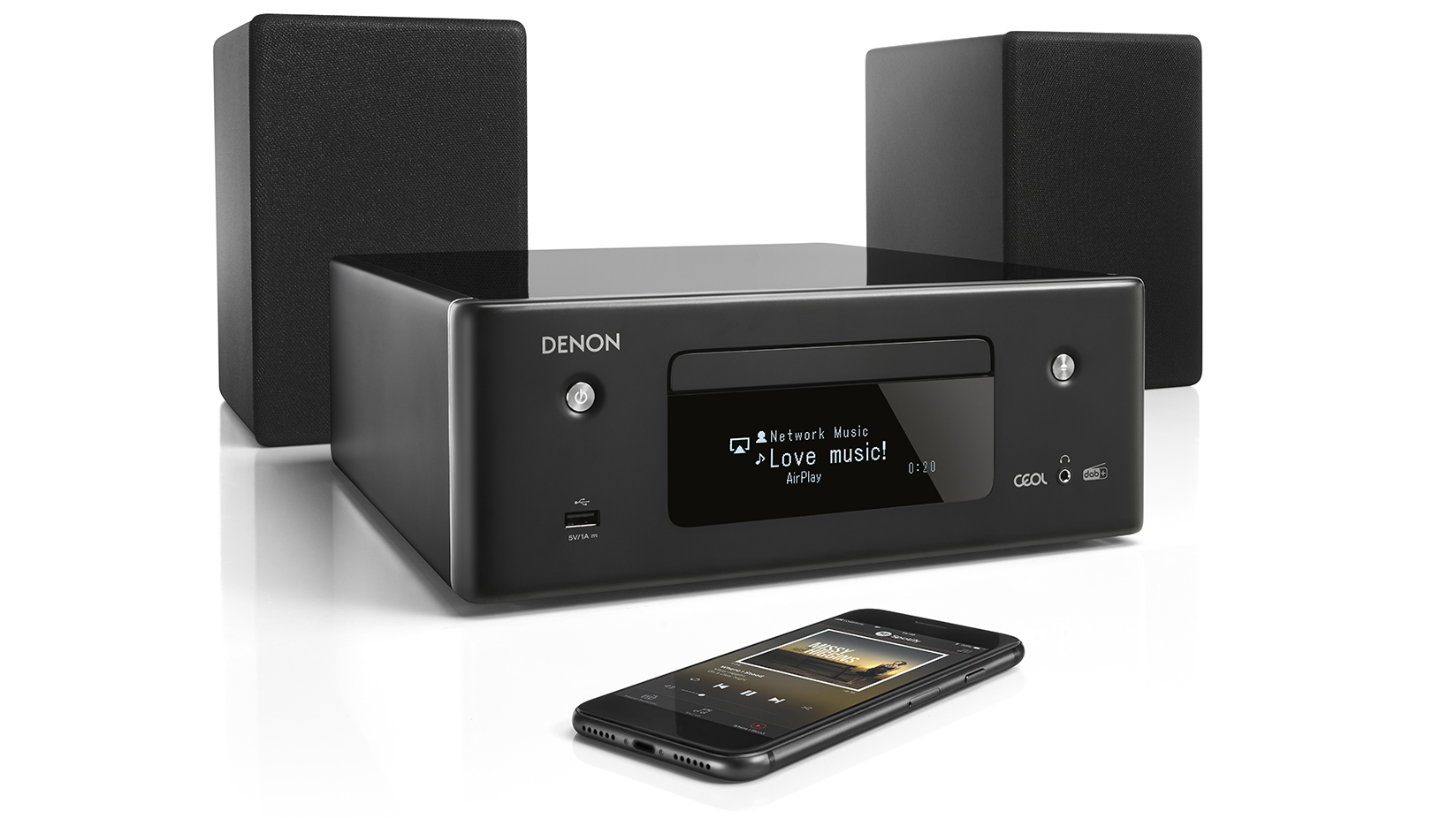
Performance
Knowing all that the unit can do, it’s a remarkably unprepossessing unit to unpack. The speakers came in the first box, the central electronics in the second, along with speaker cables of two-metre length – if you need the speakers further apart, bring your own. We were set up in no time, using Ethernet for instant networking, and already having the HEOS app ready to roll on our various devices from previous reviews.
We were then spoiled for choice of control. There are some rather swish touch buttons on the scratch-resistant top of the unit itself; these keys are back-illuminated and light up when you touch them, though not enough to help in a darkened room since the labels don’t illuminate, so you can’t tell what you should press. Also they only work when the unit has already been powered on. But they’re handy on a sunny day when you need to quickly mute the unit for a phone call, or similar.
The N11 also comes with a nice full-size remote control, but you can equally well do nearly everything via the HEOS app, which will wake the CEOL from sleep when you start playback from any source. While there’s full software control within the app, we were pleased to find that the volume rockers on the side of our iPhone also controlled the Denon’s volume when the HEOS app was open (though not from a lock screen), which is surprisingly often not the case, given this is the easiest and most intuitive method of volume control when using an app.
We began our listening with internet radio, which uses the excellent TuneIn platform, which in the UK has been hobbled by record company legal action so that it can’t play anything other than UK stations, but which is, as yet, free of such interference here in Australia. Indeed it is our favourite radio platform, the only one to offer our local community radio station along with quite a few others – 100,000 stations, says TuneIn, along with 5.7 million podcasts, so if it’s your first time playing with internet radio, this should keep you busy for a while.
Our local station came through with all the compression applied by their output racks but otherwise strong and clear, with spoken voices sounding accurate and sibilance-free, and with a pleasing warmth of musical presentation from speakers of this size and solidity. The CEOL’s delivery of Jeff Buckley’s version of Hallelujah flowed sweetly and swelled with emotion even from this source of lesser quality than most – the front panel display showed the signal quality, in this case 96k AAC, as well as the source and station name.
We couldn’t, among the various HEOS menus, find any way to change what the display shows when the unit is playing, though you can choose whether and how it shows the time when it’s off. You can set a time for it to turn on automatically, and the source it should play.
There are various ways to tweak the sound quality, most easily accessed from the HEOS ‘now playing’ screen. This has a left-right balance control, plus EQ offering treble and bass sliders, and a ‘Super Dynamic Bass’ option, which certainly thumps up the low end, at the expense of a slight softening of higher frequencies; this was too much for us with internet radio, indeed it’s a sign of good sonic design that we spent nearly all of our CEOL listening with the ‘Source Direct’ option engaged, thereby hopefully getting the cleanest path to music.
Check also under the main settings for the CEOL in the app; the EQ controls are repeated here but there’s also a ‘Quality’ option; we could find no explanation of this but we switched it from its default ‘Normal’ to ‘High’. Because why not.
There are a good many other settings, some of them available only by crouching next to your CEOL and using the full-sized physical remote or front panel buttons to investigate. Under the ‘Audio’ section, for example, you can tweak the level of the headphone output, and switch off ‘Speaker Optimisation’, which is the adjustment Denon has made to match the amplifier to the speakers. It works well – leave it on! But should you ever switch out the speakers as an upgrade or for other reasons, you should remember this option and turn it off, or at least try the sound without it.
While the profusion of settings might seem a little overwhelming if you go for a browse, we were impressed that the defaults were all sensibly chosen, so that anyone simply turning on and playing will get pretty much as good as the Denon can give.
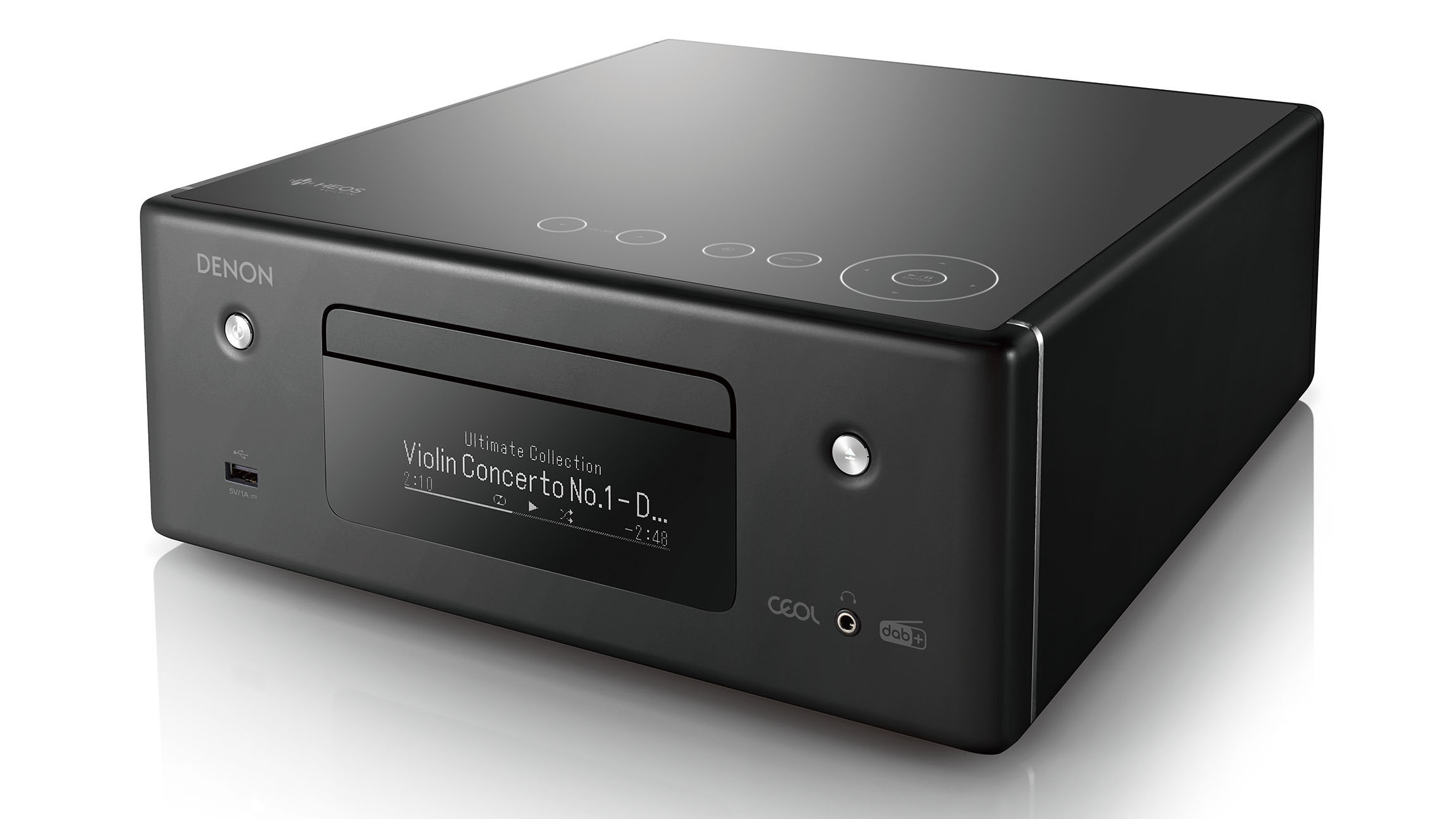
We continued to some Tidal streaming; there’s no unfolding of MQA Masters here for high-res streaming (as rival streaming system BluOS offers), but it’s arguable whether high-res is going to improve the excellent sound we enjoyed, whether punching up some bouncy REM or delivering the drifting flow of Philip Glass’s Closing. There was a limit to the size of bass the speakers could deliver, but the deep underlying organ note under Closing was certainly present, if not fully resonant.
With electric bass the CEOL could drop all the way to the bottom E, and the sonic booms of Aimee Mann’s Nobody Does It Better were pleasingly expansive, the throbbing bass of this track was brought to the fore even without any of the EQ options engaged. Nice.
A frequency sweep indicated that (in our listening room) the system was reproducing tones down into the 30s of hertz, finding its full strength in the 60s and 70s and rising impressively smoothly from there. Since the speakers are rear-ported, positioning will affect this somewhat, but can also be usefully employed to tweak it.
Equally enjoyably the higher frequencies were never sibilant, and the bass, while sometimes dominant, never closed down the treble in the process. There’s not the full open soundstaging of full-sized hi-fi separates with a higher-specification amplifier, but there are plenty of hi-fi attributes delivered here, and definite musicality.
Alex The Astronaut’s bold ‘Like A Version’ take on Mr Blue Sky sailed through the CEOL, the room acoustic clearly audible around Lindy Morrison’s drums, Alex’s nervous guitar solo pleasingly clicky, the bass never dipping even on its lowest notes, and the careful harmonies lifted above it all; this was fine work on this delightful recording (we played it twice, just for the joy of it).
We played high-res from USB, confirming its abilities with WAV, FLAC and Apple Lossless to 192kHz, and DSD to 2.8 and 5.6MHz, as well as playback of the lesser likes of MP3, AAC and WMA.
Bluetooth here lacks any codec above the base-level SBC, not even AAC, so might be considered a weakness, except that there’s nearly always a workaround via HEOS to play from the same source at a higher quality.
We nearly forgot the CD player, so sidelined has this format become in our lives today. But those with silver to spin can be assured that this source was a highlight in terms of clarity and dynamics. The Painted Ladies’ version of Vic Simms’ Poor Folks Happiness drove forth with a full bassline, vocals and guitars well defined.
Angel from Louis Armstrong’s album Louis & the Angels with arranger Sy Oliver had the band sounding smooth and deep, while Satchmo’s horn blasted forth so surprisingly bright and loud that you suspect he’d shuffled several steps forward since the sound check when the engineers set the levels. Greater hi-fi will open this further and bring the band into sharper relief, but this was still a beguiling sound, with plenty of level in reserve.
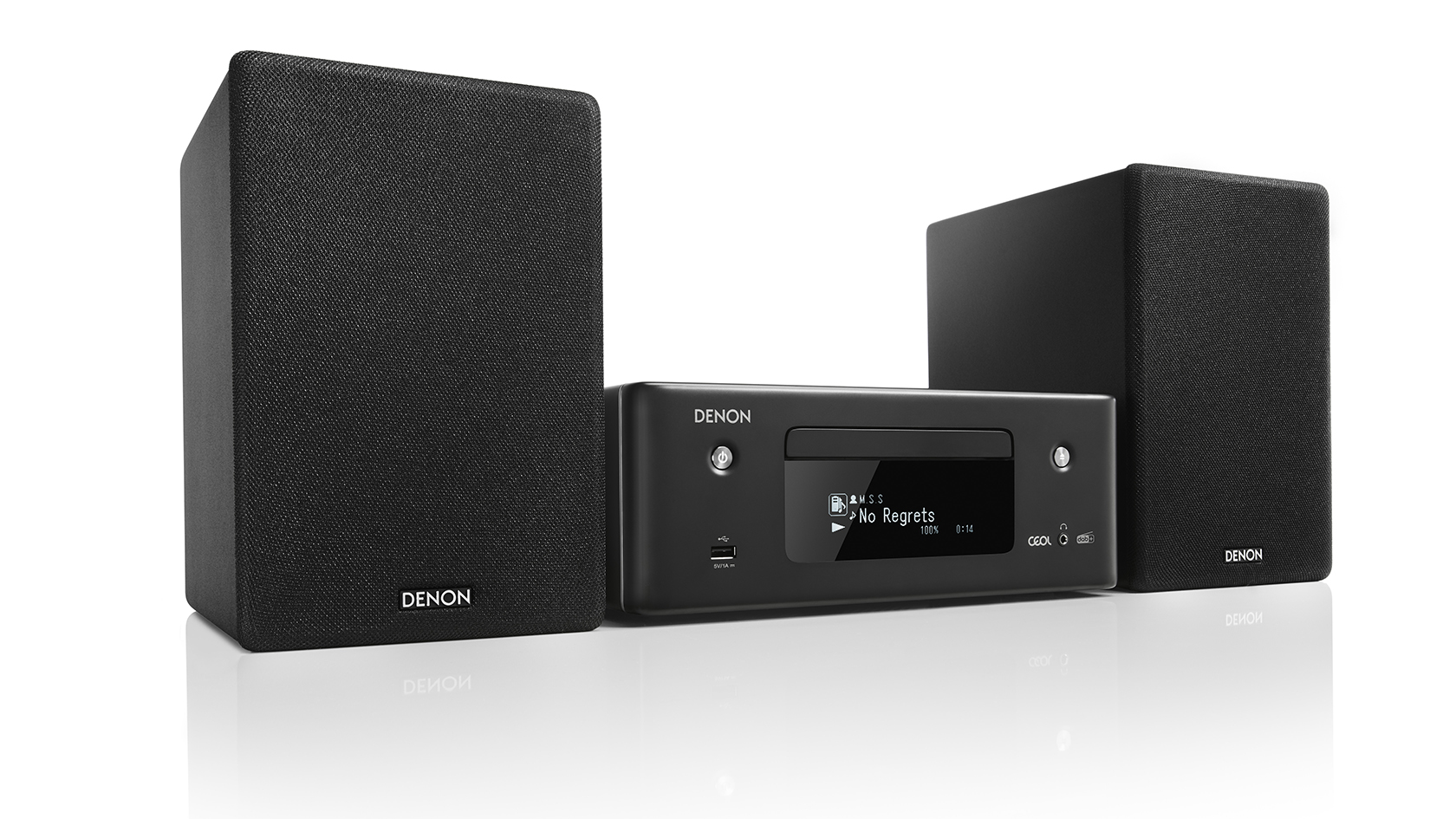
Verdict
With this sound at this price and with so very many ways to play, there’s nothing to criticise here, other than the old ‘systems vs separates’ caveat of not being able to upgrade or swap out a single element of an all-in-one system. But that aside, Denon has the modern mini system thoroughly nailed here.
Sound+Image is Australia's no.1 mag for audio & AV – sister magazine to Australian Hi-Fi and to the UK's What Hi-Fi?, and bestower of the annual Sound+Image Awards, which since 1989 have recognised the year's best hi-fi and home cinema products and installations. While Sound+Image lives here online as part of our group, our true nature is best revealed in the print magazines and digital issues, which curate unique collections of content each issue under the Editorship of Jez Ford, in a celebration of the joys that real hi-fi and high-quality AV can bring. Enjoy essential reviews of the most exciting new gear, features on Australia's best home cinemas, advice on how to find your sound, and our full Buying Guide based on all our current and past award-winners, all wrapped up with the latest news and editorial ponderings. Click here for more information about Sound+Image, including links to buy individual digital editions and details on how best to subscribe.
-
splinternet Any recommendations for possible speaker upgrade and/or subwoofer? I have a large Victorian conservatory where I want to set up a streaming system like this Denon package, and may need speakers with more oomf.Reply -
RobF Depends what you'r looking for: Real excellent HiFi or good quality set with many digital options for a reasonable price. Bought the set including speakers, but use it with speakers i already had (which were as expensive as the set); i'm happy with the combination. Controll all options via HEOS-app on my iPad.Reply
In the end, it's a matter of taste and the amount of money you're willing to spend :) -
Gelatinous_Blob I've had the CEOL N11 for perhaps three months now, paired with Dali Oberon 1 speakers and a B&W ASW608 subwoofer. I don't quite love it. For some, sparse tracks with well isolated notes and vocals it can sound lovely, but it becomes a bit incoherent where there's more going on. I've not quite nailed the bass organisation either, which sometimes lacks definition or feels a bit late to the party, though this could be down to my own inexperience in setup with the subwoofer. The HEOS app is barely usable: TuneIn radio doesn't work for any BBC stations without a subscription and the interface is so cluttered with Podcasts that I couldn't easily find live streams from the likes of Fip. The Amazon Music implementation means your own playlists aren't visible and the search functionality is clumsy - all of which means switching from Spotify Connect to Amazon Music for HD quality isn't an option. I haven't tried Tidal with the CEOL yet but will do so.Reply
On a side note I did try the Denon SCN10 speakers that are bundled with the CEOL, but found them boomy and this added to the general incoherence of some music, though I felt they had potential if they could be positioned well away from a wall. With a compact system like this it's highly likely most users will have the speakers on book shelves or seek to mount them on the wall, and the SCN10s really aren't suited to this thanks to a very lively rear port and a complete lack of wall mounting points.
When the moment is right I think I'll upgrade the CEOL to a Bluesound Powernode (£850) which comes with bass management, more power, a well regarded amp technology and the BluOs platform, which I hope would be better than HEOS.
If I was to do it all again with the same budget I would go for the Yamaha WXA50 (£450) - a neat streaming amp at a similar price to the CEOL, but which comes well reviewed for sound quality (see Audio Science Review) with the Musicast platform (which I have used extensively).
Don't get me wrong, the CEOL is a great mini system that delivers huge functionality with a small (though not particularly attractive) footprint. But this is mini-system sound quality, and a significant uptick in sound quality will be possible if you're prepared to ditch DAB and the CD player.
